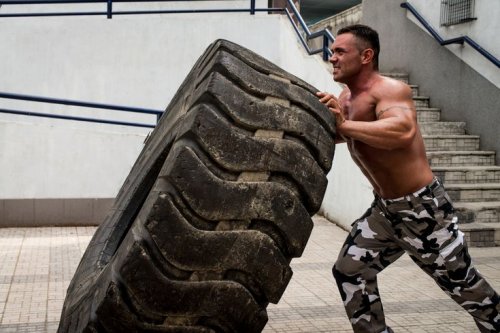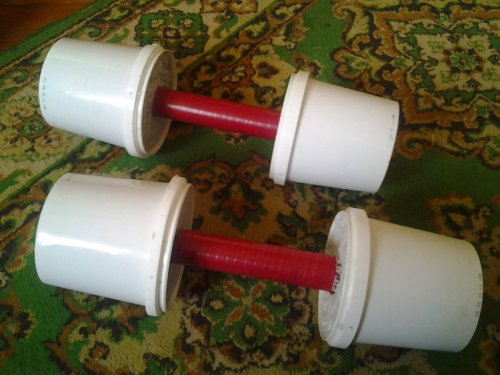
We've talked about “quick-fix exercise equipment” more than once. And sometimes you don't even need to make exercise equipment; you just need to find suitable (and inexpensive!) items, without any modifications.
One of my favorite pieces of equipment is a car wheel. Or a tire; they're used identically. We won't be riding on them, though. We'll use the tire or wheel as a training tool. So, without further ado, we'll just use an old, unwanted wheel.
This equipment has many advantages. First of all, its shape allows for different grips and positions. Secondly, it allows you to choose the right weight and size for your needs. Wheels vary, so finding the right one is easy if you want.
And of course, the unconditional advantages are durability (I would even say indestructibility) and availability.
The tire is a multifunctional item used for: strength exercises; coordination exercises; practicing punches.
Just warm up first! And be especially careful with your first few workouts, as dynamic exercises put a lot of strain on your ligaments.
Actually, a large tire or wheel is more of a true strength piece of equipment. A truck tire, or even a larger one, is fine. Getting one isn't a problem, but storing it… That's more for a home or outdoor training area. Then you can find a set of tires and wheels for every conceivable exercise!
What can you do with a wheel as a piece of equipment? Various things, starting with using it as a simple kettlebell. But even just lifting, pulling, and pushing wheels is different from kettlebell training. Wheels don't have a handle. No, and you don't need one! The unusual shape requires different grips and different muscle work in seemingly similar exercises. The wheel also allows you to vary your grips, changing and redistributing the load. Couldn't this help stimulate muscle growth? It also allows you to engage a range of muscles not typically included in standard exercises, or engage muscles in unusual combinations. In other words, it diversifies the load.
But the wheel/tire isn't just used for strength work in the traditional sense. It's used for wide-range movements: all sorts of swings, rocking movements, and spinning movements. Just don't be fooled by relying too much on momentum. The goal isn't to “simply swing” the object, using inertia to do the work for you. Unfortunately, such work is of little use. Therefore, even when working with wide ranges of motion—swinging movements, rocking movements, and spinning movements—control the equipment. Reduce the amount of momentum you let inertia do the work for you.
The grip makes a huge difference. It's not a kettlebell, after all; there's no handle.
The easiest way to grip a tire is by the inside edge. Similarly, a complete wheel with a rim is by the edge of the hole in the rim. There are smaller, narrower wheels—from motorcycles, scooters, and walk-behind tractors. The thickness of the rib on the tread side allows for one-handed grip. If this grip doesn't allow for a full, full-range arm movement, engage your legs and core. It's okay to create a slightly different exercise than you're aiming for—unless you're trying to work a specific muscle group. Such methods are generally more focused on developing body structure than on building muscle.
Holding a wheel in each hand, shadow boxing is comfortable. Although… did I say “comfortable”? I was wrong! It can be comfortable in a warm bed, but during training it can be difficult and challenging. No, it can be easy and enjoyable—but only if you're at a serious level of training. If training is easy for a beginner, chances are they're just not training.
This is especially true for our improvised exercise equipment. Their inconvenience is precisely what forces us to coordinate our muscles differently than with “normal” equipment. This more complex, unfamiliar coordination stimulates muscle development. It also stimulates the nervous system, since it controls the muscles.
We use two small wheels for shadow boxing; the larger wheel for pushing. Holding the wheel in both hands, we sharply push it in front of us. Perform it correctly: don't simply “throw” the wheel in front of your chest and back; engage your entire body in the movement. The main force here comes from your legs, not your arms.
By the way, this also applies to boxing.
You can also toss and catch a tire (I haven't tried this with a wheel!), including letting the projectile spin in the air. Just be careful!
You can toss the projectile from hand to hand, combining the tosses with other movements. For example: swing (or rotate, or any other movement you like) with the hand holding the tire, toss the projectile to the other hand, and then do the same movement with the other hand.
The wheel can be used as a support for bodyweight exercises, like push-ups. How? Place the wheel on the floor in a push-up position, with your palms on the edges of the wheel. Or, place two wheels on the floor, shoulder-width apart (vary the distance depending on which muscles are working); place your palms on the wheels and perform push-ups between them, trying to get as low as possible.
With a heavy wheel you can perform bends and rotations of the body.
Finally, you can try this exercise outside or at the gym: swing and throw a tire/wheel as far as possible. After sending the tire flying, immediately run after it. Catch up, catch or pick it up, and throw again. And so on, as far as your strength allows.
It is especially interesting to perform this exercise when the wheel does not fall immediately, but rolls along an unpredictable trajectory.
And of course, a tire is an excellent target for practicing punches, both on its own and as the basis for a target trainer.
But we'll talk about martial arts training equipment separately. And we'll come back to tires later…






